Procurement Management Plan: What is it & How to Create One
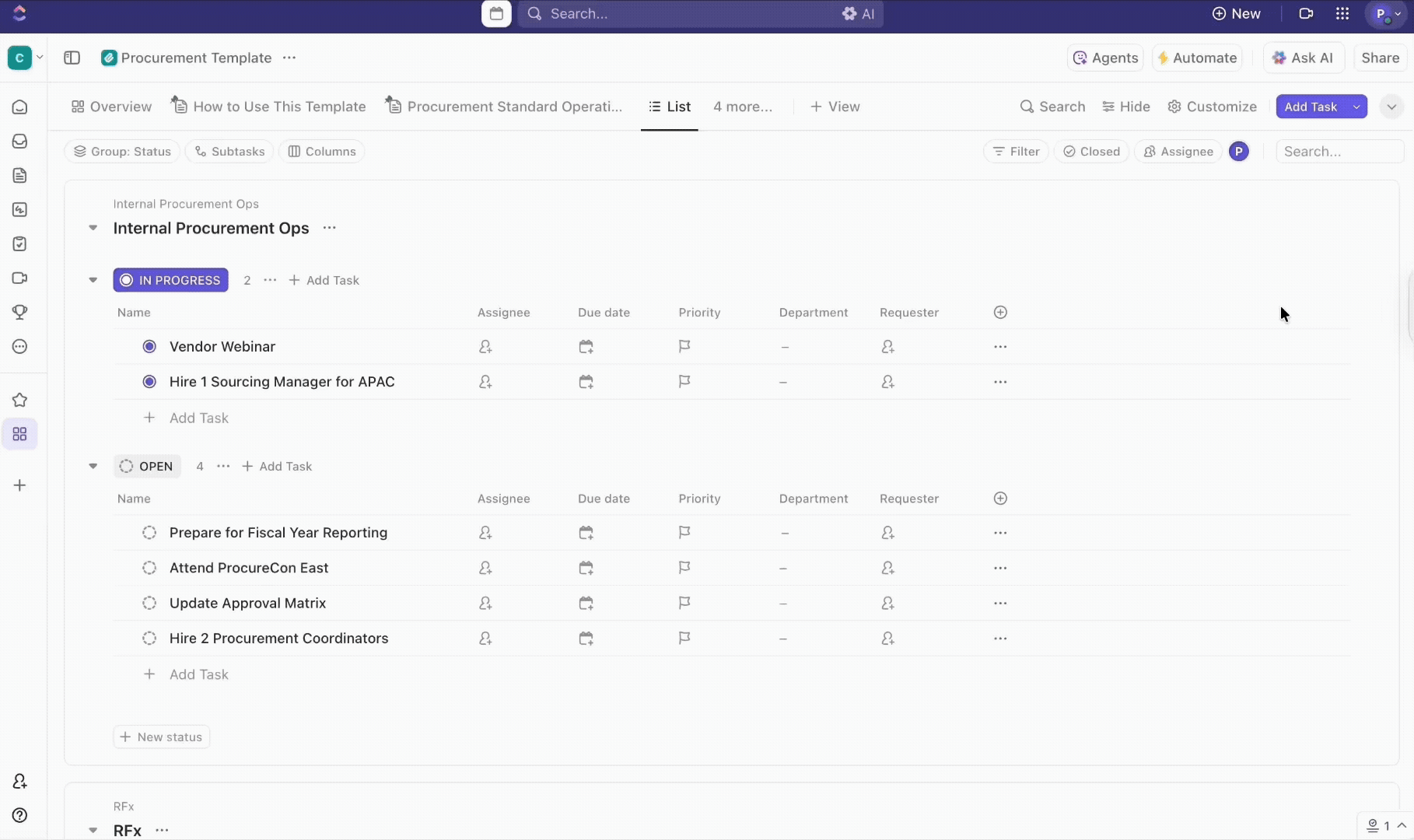
Sorry, there were no results found for “”
Sorry, there were no results found for “”
Sorry, there were no results found for “”

Procurement is stepping into the spotlight. About 64% of professionals, who took part in the Global State of Procurement Survey, say its influence is growing within organizations.
As procurement teams take on a bigger role, they’re also facing new challenges, especially when it comes to outdated and inefficient processes.
That’s where a smart procurement management plan makes all the difference. It’s your roadmap for making confident purchasing decisions, keeping costs in check, and building strong supplier partnerships.
With the right plan in place, you can reduce risks, boost supplier alignment, and stay in control of your budget. Are you ready to take your procurement process to the next level?
Let’s break down the key steps to creating a winning procurement management plan—so you can streamline your workflow and deliver standout project results.
A procurement management plan outlines how an organization or project team will procure the necessary goods and services from external providers.
The plan is a strategic document outlining procurement objectives, factors for selecting suppliers, contract control processes, and measures to avoid risks. It ensures that procurement activities are synchronized with the project schedule, cost, and quality expectations.
An effective procurement plan avoids supply chain disruptions, cost escalation, and compliance problems. It clearly defines roles and responsibilities, ensuring smooth coordination among stakeholders, procurement teams, and project managers.
🧠 Fun Fact: The first large-scale procurement contract dates back to around 3000 BC. It supplied stone and labour for Egypt’s pyramid construction. The oldest written contract, found in Mesopotamia, appeared on a clay tablet.
The Procurement Template by ClickUp helps streamline your entire purchasing workflow—from vendor selection to order tracking. Easily manage requests, approvals, and budgets in one place to keep procurement efficient, organized, and audit-ready.
In project management, procurement is a driving force behind successful outcomes.
It ensures that teams have timely access to the right resources, all while keeping costs in check and minimizing risks. By establishing clear contracts, setting delivery schedules, and defining quality standards from the outset, procurement managers lay the groundwork for projects to run smoothly.
Effective procurement management also strengthens supplier relationships and enforces contract compliance, reducing the likelihood of delays or budget overruns. Just as importantly, it brings transparency to the entire process—tracking purchase orders, approvals, and vendor performance—so everyone stays informed and aligned.
Ultimately, strong procurement practices are essential for delivering projects on time, within budget, and to the highest standards.
👀 Did You Know? 21% of decision-makers and 24% of senior leaders want their procurement teams to become more agile and resilient to supply chain disruptions.
A formal plan avoids unnecessary expenditure, delay, and non-compliance on the part of the organization. It’s important for the following reasons:
An effectively worded procurement plan helps organizations optimize spending by preventing unnecessary buying and securing competitive prices from suppliers. It allows firms to negotiate better terms, establish improved supplier relationships, and reduce costs.
📌 Imagine a marketing team needing event materials. Instead of buying from multiple suppliers at last-minute prices, a procurement plan helps them negotiate annual contracts with preferred vendors, saving both money and time.
A procurement plan ensures that purchasing activities are aligned with overall organizational objectives. By anticipating procurement objectives, companies can schedule important purchases, avoid unnecessary expenditures, and enhance financial planning.
📌 Consider a construction company planning multiple projects over the year. With a procurement plan, the procurement team can align bulk material purchases with project timelines, securing discounts while avoiding stockouts.
A procurement management plan ensures that there are clear supplier selection criteria under which businesses are assured to deal with reliable vendors. With good supplier relationships, businesses can negotiate favorable contract terms, enhance the quality of services, and avoid risks associated with using poor-performing suppliers.
📌 Picture a retail company evaluating suppliers annually through scorecards based on delivery timelines and quality. A strong procurement plan enables them to replace underperforming vendors before customer satisfaction drops.
Organizations must adhere to internal policies and external legislation when procuring. A formal project management plan guarantees all procurements are compliant, preventing legal issues, fines, or loss of reputation through non-compliance.
📌 A healthcare company, for instance, must ensure all medical equipment purchases meet government regulations. A procurement plan embeds compliance checks into every purchase decision, reducing legal risks.
Procurement is risky in the event of supplier failure, price fluctuation, and quality problems. A procurement management plan includes risk management processes, such as assessment, contingency planning, and alternative sourcing, to minimize disruption to operations.
📌 Imagine a manufacturing firm sourcing key components from overseas. When shipping delays occur, a backup supplier listed in the procurement plan ensures production lines continue running without major losses.
Without a documented process, procurement activities are prone to inefficiency and waste. With an accurate plan, organizations can reduce administrative costs and subsequently focus on critical business operations instead of repeating procurement processes.
📌 Think about a fast-growing SaaS company onboarding multiple vendors for software subscriptions. A streamlined procurement process reduces paperwork and vendor confusion, enabling employees to focus on delivering product improvements rather than chasing approvals.
👀 Did You Know? With ongoing supply chain disruptions, rapid technology changes, and the need for a smoother process, 47% of supply chain leaders deal with operational inefficiencies.
A procurement management plan has three key components:
| Component | What it stands for |
| Procurement strategy | ✅ Outlines the overall direction for acquiring goods and services ✅ Dictates what should be procured, when, and the budget limitations ✅ Ensures procurement aligns with organizational goals while optimizing cost and efficiency |
| Procurement process | ✅ Describes the sequential procedures for procuring goods and services: identifying needs, selecting suppliers, negotiating contracts, and managing operations ✅ Guarantees cost-effectiveness and timely delivery |
| Procurement control plan | ✅ Formulates a process for gauging procurement activity ✅ Focuses on containing costs, controlling quality, and ensuring compliance with policies and laws ✅ Keeps procurement on budget while supporting organizational purposes |
In addition to these three, other components include:
| Additional components | Why they matter |
| Procurement objectives and goals | Clearly defined objectives propel the procurement process forward |
| Stakeholder identification and engagement | Effective procurement planning involves participation from major stakeholders such as department heads, contract managers, and end-users |
| Market analysis and supplier selection | A strong procurement plan includes comprehensive market research to identify good suppliers. Price, delivery lead time, and supplier performance are key parameters for making intelligent buying decisions. |
| Budget and cost considerations | The procurement plan should include all purchasing expenses—direct costs, tax, logistics, and installation. Monitoring expenditures via procurement software helps organizations stick to a budget and prevent overspending. |
| Risk assessment and mitigation | Procurement involves risks like supplier delays or quality issues. A good plan includes risk assessments and mitigation strategies, such as identifying alternative suppliers or implementing contingency measures to reduce disruption. |
| Procurement schedule and timeline | A formalized timeline ensures procurement activities align with project schedules. It includes key milestones like vendor selection, contract signing, and delivery schedules to keep processes on track. |
| Contract administration and management | Sound contract administration ensures vendors adhere to agreed terms, facilitates negotiations, ensures compliance, and manages contract amendments. This safeguards organizational interests and enhances supplier relationships. |
| Performance measurement and evaluation | Tracking procurement performance through Key Performance Indicators (KPIs) enables measurement of supplier reliability, cost, and efficiency. Regular checks help organizations rationalize their procurement strategy and improve performance. |
💡 Pro Tip: Procurement teams and suppliers must collaborate closely to modernise operations. By scaling partnerships intentionally, they can match procurement’s expanding role across the organisation.
The right procurement management plan can enable an organization to purchase appropriate goods and services at the best possible value, while also achieving efficiency, compliance, and savings. The following is a step-by-step process for developing a clear procurement plan.
The first step in planning procurement is to create explicit objectives matching those defined in business objectives. Organizations need to know clearly what they want to procure, why, and what they expect out of the procurement.
A successful procurement plan will explain how an organization will acquire goods and services most cost-effectively and reliably. The steps would include:
After identifying procurement requirements and strategies, understanding the potential suppliers and invitation-to-bid activities would follow. These are Requests for Proposals (RFPs) or Requests for Quotations (RFQs) to solicit competitive bids. This must contain:
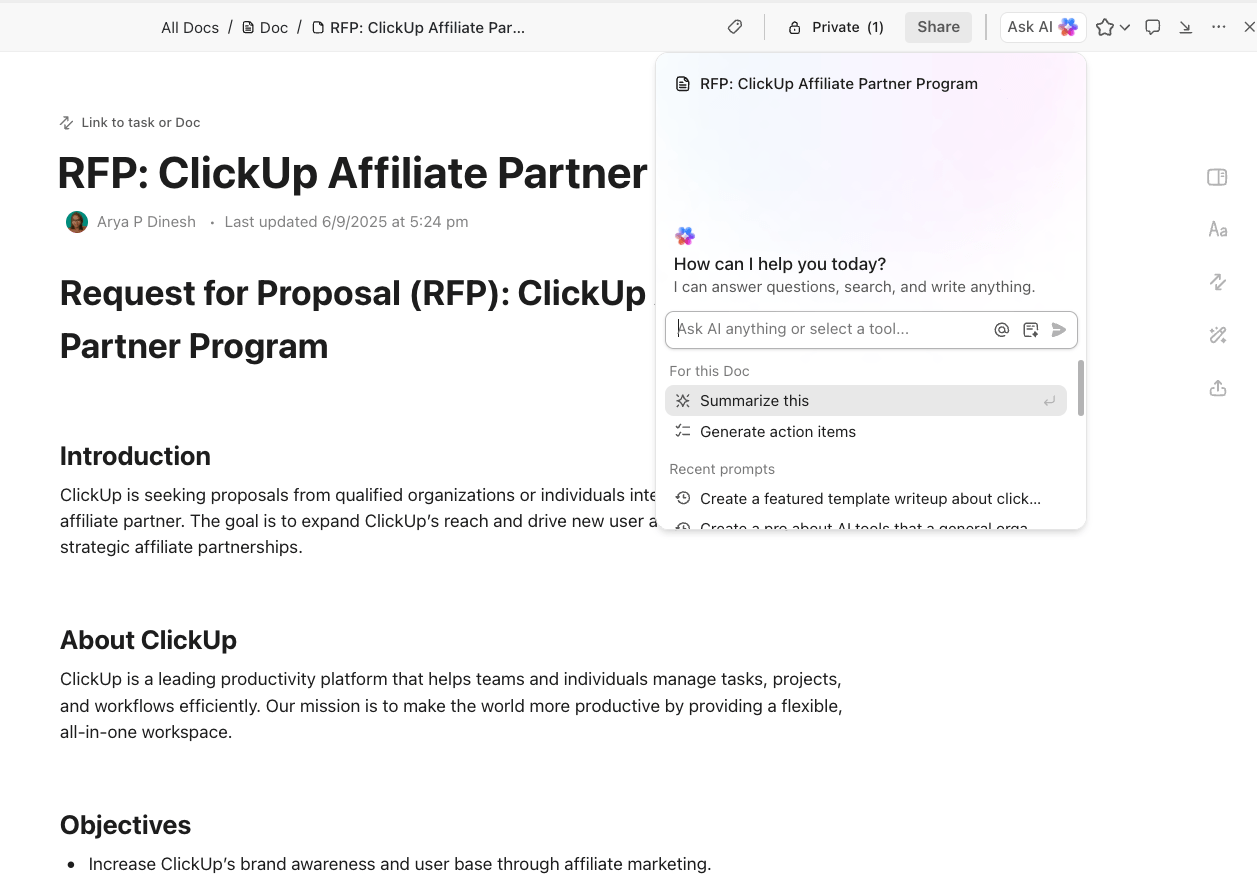
With the bids now in, the firms have to compare suppliers against defined parameters for assessment. An effective assessment process should consider the following:
Shortlisted suppliers can be further negotiated before the contract agreement to make the best deal.
Once a supplier is selected, organizations must monitor the efficient delivery of procurement and ensure compliance and quality control. The following are the major activities within this phase:
👀 Did you know? A 10% reduction in supplier costs can boost EBITDA by 32% for Fortune 500 companies and 27% for FTSE 350 businesses, unlocking major profitability gains.
The right tools can bring procurement efficiency, cost savings, and adherence to policies. Modern procurement software and project management solutions help streamline processes, automate activities, and offer visibility of expenditures. Below is a list of some of the top procurement planning management tools:
With procurement software, companies can manage supplier relationships while monitoring purchasing activity and automating procurement. Some of the well-known solutions include:
A cloud-based procurement solution for streamlining sourcing, contract management, and collaboration with suppliers. It helps organizations obtain a better deal and optimize spend with real-time visibility into procurement activity.
An excellent solution that automates buying, supplier qualification, and contracting. It ensures compliance with procurement policy and simplifies procurement.
A comprehensive procurement solution for spend management, supplier risk management, and auto-approval workflows. Coupa integrates with financial systems for real-time budget monitoring and control of costs.
🧠 Fun fact: Procurement managers do more than just order items; they negotiate contracts, ensure quality, and analyze vendor performance. They are often seen as the unsung heroes of the corporate world, balancing cost management with quality assurance
ClickUp, the everything app for work, brings all your timelines, tasks, and contracts into one unified workspace. From drafting agreements to tracking deliverables and approvals, ClickUp helps you stay on schedule, control costs, and manage vendor accountability—every step of the way.

ClickUp’s CRM Software for Procurement Managers provides procurement managers with a single source of truth to manage every aspect of the supplier lifecycle.
Forget scattered spreadsheets and email chains. ClickUp CRM keeps all supplier data, such as contacts, contract terms, performance history, and documents, in one place, so your team always knows where to look and what’s next.
It can help you:
Overall, ClickUp connects with your favorite procurement tools, ERPs, and communication apps to keep your workflows running without interruption.
David U shares his experience:
My favorite aspect of ClickUp is its customizability. You can tailor everything—views, statuses, fields, automations—to match your workflow perfectly. It adapts to you, not the other way around.
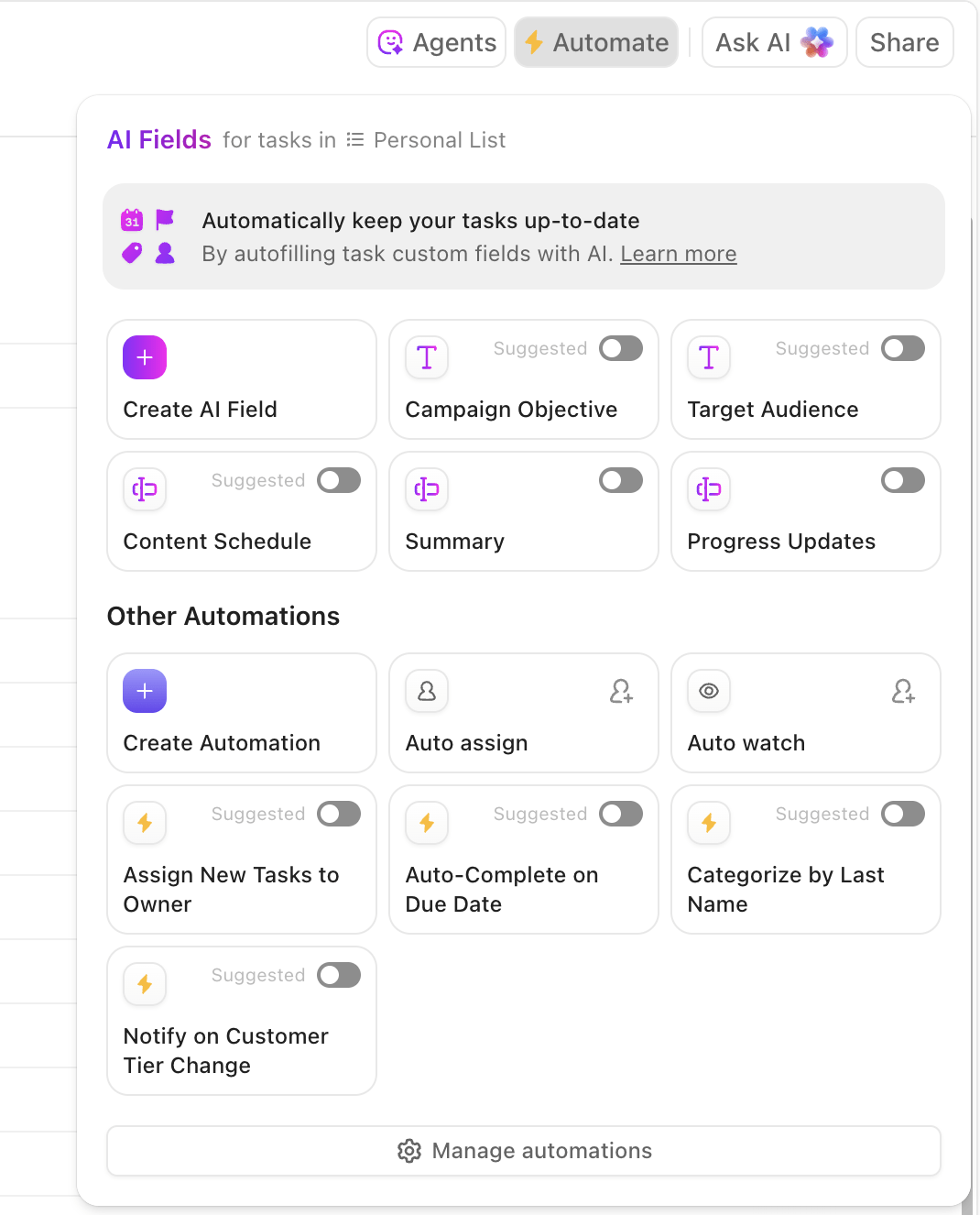
ClickUp Automations eliminate manual tasks, ensuring a more efficient procurement process. With over 100 automation options, procurement teams can automate routine activities such as:
These automations reduce the risk of human error and free up valuable time for strategic decision-making. With custom automation rules, teams can tailor workflows to their specific procurement needs, leading to increased productivity and consistency across projects.
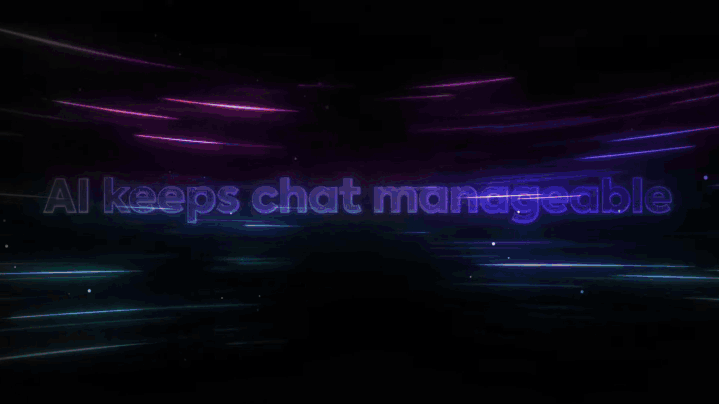
Effective communication is a non-negotiable in procurement. ClickUp offers a suite of collaboration tools that facilitate seamless interaction between procurement teams and suppliers:
Create dedicated spaces for each supplier to centralize communication and documentation. Use real-time Chat in ClickUp to engage in instant messaging to resolve issues promptly, which also improves vendor relationships.
Collaborate on contracts, proposals, and other essential documents via ClickUp Docs within the platform using document sharing. These features ensure that all stakeholders are aligned, reducing misunderstandings and fostering stronger supplier relationships.

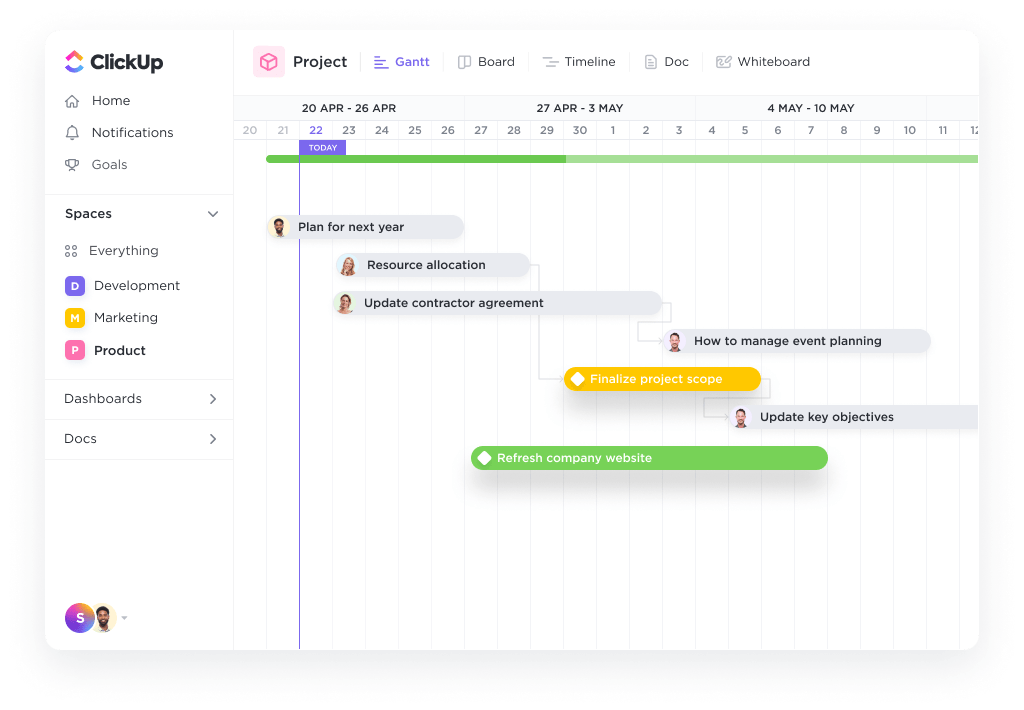
Monitoring progress is vital to keep procurement projects on schedule. ClickUp’s milestone tracking capabilities provide clear visibility into project timelines.
Define key procurement stages as milestones to monitor progress. Visualize the entire procurement timeline using Gantt charts, identify dependencies, and adjust schedules as needed. Avoiding delays is key to controlling procurement costs.
Use visual cues to assess the completion status of each milestone. These tools enable procurement managers to proactively address potential delays and ensure the timely delivery of goods and services.
The ClickUp Procurement Management Template is designed to provide a comprehensive framework for managing procurement processes from initiation to completion. Key features of the template include:
Many moving pieces are involved in managing procurement, including supplier selection, procurement budget control, compliance, and risk management. A disruption anywhere in the procurement stream can lead to inefficiencies that cause budget insufficiencies or risks tied to poor suppliers.
These procurement challenges demand end-to-end strategic management, proper technology use, and strong collaboration among stakeholders.
Suppliers are crucial to an organization’s successful procurement. However, it has associated risks like not meeting expected quality, delays in delivery, or an unstable financial position, which can, in turn, affect operations. The risks can easily be controlled through:
Cost overruns are common problems in procurement, especially when an emergency cost is incurred or the supplier increases the price. In maintaining good fiscal discipline, always:
Multiple internal policies, industry regulations, and legal requirements must operate within procurement processes. Compliance failures can lead to penalties, forcing an organization to deal with reputational damage or contract disputes. To avoid these situations, it is important to:
Unexpected events, such as global disruption to the supply chain, a shortage of raw materials, or delays in transportation, can slow down the procurement processes in an organization. Resilience-building may require:
Manual processes within procurement can easily stray towards inefficiencies, errors, and a lack of visibility in spending. To improve procurement operations:
Various departments involved in procurement efforts include finance, operations, and legal teams. Misalignment of various interested stakeholders can slow things down or cause internal miscommunication. To fulfill collaboration:
The procurement sector is changing faster due to advancements in AI, automation, and analytics. Companies that do not adapt will surely have issues with inefficiencies. To remain competitive:
💡 Pro Tip: Create custom dashboards in ClickUp to visualize procurement metrics. Monitor key KPIs, including delivery times and quality, to make informed decisions and optimize your procurement strategy.
Smart procurement is the backbone of successful projects, keeping everything on track and within budget. Relying on scattered, ad hoc processes can lead to inefficiencies, compliance risks, and costly delays. That’s where ClickUp stands out.
It isn’t just another project management tool—it’s your all-in-one platform for streamlined, compliant, and data-driven procurement. With ClickUp, you can centralize every step of your procurement process, collaborate seamlessly with stakeholders, and gain real-time visibility into budgets, timelines, and supplier performance.
Take control of your procurement strategy and drive better results—faster. Get started with ClickUp for free today!
What are the 5 components of a procurement management plan?
A procurement management plan typically includes several key components to ensure a smooth and effective process. First, it outlines the procurement objectives and goals, clarifying what the organization aims to achieve. It also identifies and engages stakeholders, ensuring that everyone involved understands their roles and responsibilities. Supplier selection criteria are established to guide the evaluation and choice of vendors. The plan sets a procurement schedule and timeline, mapping out important milestones and deadlines. Finally, it includes a risk assessment and mitigation strategy to anticipate potential challenges and outline steps to address them.
What does a procurement management plan do?
A procurement management plan serves as a roadmap for acquiring the goods and services needed to complete a project successfully. It defines how procurement activities will be managed, from planning and supplier selection to contract administration and performance monitoring. By providing structure and clarity, the plan helps ensure that purchases are made efficiently, cost-effectively, and in alignment with the project’s objectives. It also helps minimize risks, streamline communication, and keep the project on track.
What to include in a procurement plan?
A comprehensive procurement plan should cover all aspects of the purchasing process. This includes the project’s objectives and scope, as well as the roles and responsibilities of key stakeholders. It should detail the process for market analysis and supplier selection, outline the budget and cost considerations, and provide a clear procurement schedule. The plan must also address risk management strategies, contract administration procedures, and methods for measuring and evaluating procurement performance. Including these elements ensures that the procurement process is transparent, accountable, and aligned with organizational goals.
What are the 7 steps of the procurement process?
The procurement process generally follows seven key steps. It begins with identifying the organization’s needs and specifying the requirements for goods or services. Next, potential suppliers are sourced and evaluated through a bidding or proposal process. Once bids are received, they are assessed, and the best supplier is selected through negotiation and contract award. The contract is then managed to ensure timely delivery and adherence to agreed terms. Finally, the process concludes with evaluating supplier performance, documenting lessons learned, and formally closing out the procurement. This structured approach helps organizations achieve cost savings, maintain quality, and reduce risks throughout the procurement lifecycle.
© 2025 ClickUp